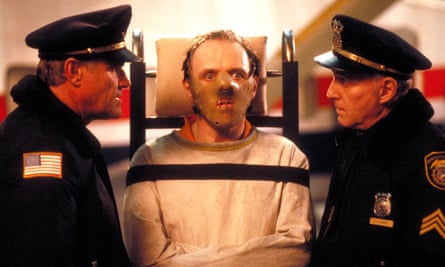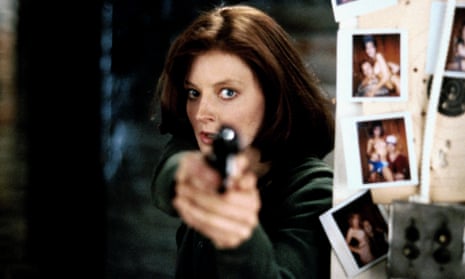“You know what you look like with your good bag and your cheap shoes? You look like a rube.”
It takes almost no time for Hannibal Lecter, the mightiest of all fictional serial killers, to size up Clarice Starling in The Silence of the Lambs. This Lecter is not like the passive monster Brian Cox had played in Manhunter, Michael Mann’s 1986 adaptation of Thomas Harris’s Red Dragon. Cox’s version is disengaged, as if humankind were a bore and a hassle, but Anthony Hopkins’s Lecter asserts his serene brilliance and power at every opportunity, which here means taking the scalpel to the FBI trainee sitting a few feet and a wall of thick glass away from him.
Though a promising student – and, it should be said, clever and cunning enough to attract Lecter’s interest – Clarice has already been cast as the rube before Lecter gets a look at her. Her superior in the bureau’s Behavioral Science Unit, Jack Crawford (Scott Glenn), has sent her to Lecter with a questionnaire that might help the FBI in its pursuit of Buffalo Bill, a serial killer who has been targeting young women and removing their skin. Crawford privately has no expectation that he will get a questionnaire back, but he suspects that Clarice will provoke him, which is exactly what happens.
The back-and-forth between Lecter and Clarice in their first meeting is the most famous scene in The Silence of the Lambs, with its impeccable stagecraft and memorable lines, and the electric chemistry between the actors. But Clarice is utterly leveled by their exchange, brought low by how easily Lecter picked up on her clothing and accent and strained professional affect, and correctly discerned that she was “not more than one generation removed from poor white trash”. After the meeting – which ends, cruelly, in an additional trauma unrelated to Lecter – she can barely stagger back to her old Ford Pinto. She has succeeded as Crawford hoped, but she feels in every way defeated.
Much of the force of The Silence of the Lambs comes from this conception of Clarice as a woman of intense vulnerability and deep resolve. There is a duller version of the character who is merely strong, precocious in her insight and constantly underestimated by the men around her. That’s not how Jodie Foster plays her, and it is not how the director Jonathan Demme, working from a script by Ted Tally, chose to conceive her. There are plenty of film-making reasons why The Silence of the Lambs set a new standard for studio horror 30 years ago – Tak Fujimoto’s lighting effects, Howard Shore’s ominous yet subtly poignant score, even the title design – but the most essential element is locking the audience into Clarice’s perspective as she pads around in the dark, first figuratively and then literally. She is scared, and so are we.
Demme was never the obvious choice to direct a film like The Silence of the Lambs, which is exactly what made him the right choice. It’s not as if he was unschooled in genre – he was a star graduate of the Roger Corman school, and the last third of his 1986 comedy Something Wild gear-shifted into startling violence – but Demme was better known for the warmth and buoyancy of films such as Melvin and Howard and Married to the Mob, not a taste for the macabre. And so that becomes a critical tension embedded in the film: a subgenre that requires the itemization of deadly fetishes and psychotic impulses, and a director who insists upon emphasizing humanity where he can find it. That is what its imitators – and its terrible sequel, Hannibal – usually miss.
While the greatness of The Silence of the Lambs has been affirmed from the start – at the time, it was only the third film to win awards in all five major Oscar categories (picture, director, screenplay, actor and actress), along with It Happened One Night and One Flew Over the Cuckoo’s Nest – criticism of the Buffalo Bill character has trailed it from the start, and has been amplified over the years. Though the film explicitly says he is not transsexual, the association of his evolving gender with violence, expressed through the life cycle of the rare Death’s-head moths he collects, has a stain similar to Psycho 30 years earlier. Intent matters – Demme, of all people, could not be fairly accused of insensitivity – but Bill running away from his manhood does not blunt the ugly implications of his metamorphosis.

It says something that the scenes with Bill are the only ones that feel like an ordinary serial killer movie, detached from Clarice’s perspective and full of unsettling bric-a-brac. (Though even then, Ted Levine’s vocal and physical presence is immense, and Demme’s use of Tom Petty’s American Girl to introduce Bill’s latest victim is so sensational that the new movie The Little Things lifted it wholesale in the opening sequence.) What distinguishes the film is how thoroughly it documents Clarice’s efforts to navigate the world of men – populated by colleagues and serial murderers, with one group not necessarily more treacherous than the other.
Though Clarice sets herself on a path to a blood-curdling confrontation with Bill – the FBI raiding the wrong house while she blithely knocks on his door is an ingenious fake-out – she cannot escape the spindly grip of her past closing around her throat. It’s not just Lecter who insists on accessing the most harrowing moments of her childhood in a sinister “quid pro quo”, but the case itself forcing a return to her humble roots and to confront men who don’t see her as an equal, if they even see her at all. She fights for respect in ways big and small, from gently cajoling her boss for shutting her out of a conversation with local police to the desperate scramble of the finale.
Demme had been interested in casting many different actors – namely, Michelle Pfeiffer, Meg Ryan and Laura Dern – before finally settling on Foster, but it has become one of those roles where anyone else seems unimaginable. Foster’s combination of slightness and grit puts the film on edge, because Clarice’s struggle to overcome the inherent disadvantages of her size, inexperience and background are so acutely rendered at every moment. She wants to protect other women from threats she feels all around her, including from fellow trainees or superiors who might want her to succeed, too. It is a lonely, ceaseless fight and it’s palpably terrifying, no matter that she’s up for it.

Comments (…)
Sign in or create your Guardian account to join the discussion